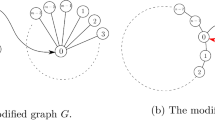Abstract
Behaviour of chemical networks that are described by systems of ordinary differential equations can be analysed via the associated graph structures. This paper deals with observations based on the interaction graph which is defined by the signs of the Jacobian matrix entries. Some of the important graph structures linked to network dynamics are signed circuits and the nucleus (or Hamiltonian hooping). We use mass-action chemical reaction networks as an example to showcase interesting observations about the aforementioned interaction graph structures. We show that positive circuits and specific nucleus structures (associated to multistationarity) are always present in a great generic class of mass-action chemical and biological networks. The theory of negative circuits remains poorly understood, but there is some evidence that they are indicators of stable periodicity. Here we introduce the concept of non-isolated circuits which indicate the presence of a negative circuit.
Similar content being viewed by others
References
Albert R, Jeong H, Barabási A-L (2000) Errors and attack tolerance of complex networks. Nature 406: 378–381
Barabási A-L, Olvai N (2004) Network biology:understanding the cell’s functional organization. Nat Rev Gen 5: 101–113
Butt JB (2000) Reaction kinetics and reactor design, 2nd edn. Marcel Dekker Inc., New York
Clare PM, Poorman RA, Kelley LC, Watenpaugh KD, Bannow BA, Leach KL (2001) J Biol Chem 276: 48292–48299
Clarke BL (1980) Stability of complex reaction networks. In: Prigogine I, Rice S (eds) Advance in Chemical Physics, vol 43. Wiley, New York, pp 1–216
Conradi C, Saez-Rodriguez J, Gilles E-D, Raisch J (2005) Using chemical reaction network theory to discard a kinetic mechanism hypothesis. IEE Proc Syst Biol 152: 243–248
Craciun G, Feinberg M (2006) Multiple equilibria in complex chemical reaction networks: II. the species-reaction graph. SIAM J Appl Math 65(4): 1321–1338
Feinberg M (1987) Chemical reaction network structure and the stability of complex isothermal reactors I. The deficiency zero and deficiency one theorems. Chem Eng Sci 42: 2229–2268
Goldbeter A, Lefever R (1972) Dissipative Structures for an allosteric model. Application to glycolytic oscillations. Biophys J 12: 1302–1315
Goldbeter A (1996) Biochemical oscillations and cellular rhythms: the molecular bases of periodic and chaotic behaviour. Cambridge University Press, Cambridge, p 605
Gouzé J-L (1998) Positive and negative circuits in dynamical systems. J Biol Syst 6: 11–15
Kaufman M, Soulé C, Thomas R (2007) A new necessary condition on interaction graphs for multistationarity. J Theor Biol 248: 676–685
Keener J, Sneyd J (1998) Mathematical physiology. Springer, New York
Klamt S, von Kamp A (2009) Computing paths and cycles in biological interaction networks. BMC Bioinform 10: 181–192
Lu TK, Khalil AS, Collins JJ (2009) Next-generation synthetic gene networks. Nat Biotechnol 27: 1139–1150
Markevich N, Hoek J, Kholodenko B (2004) Signaling switches and bistability arising from multisite phosphorylation in protein kinase cascades. J Cell Biol 164: 353–359
Mincheva M, Roussel MR (2007) Graph-theoretic methods for the analysis of chemical and biochemical networks. I. Multistability and oscillations in ordinary differential equation models. J Math Biol 55: 61–68
Othmer HG (1976) The qualitative dynamics of a class of biochemical control circuits. J Math Biol 3: 53–78
Papin JA, Reed JL, Palsson GO (2004) Hierarchical thinking in network biology: the unbiased modularization of biochemical networks. Trends Biochem Sci 29: 641–647
Purich DL, Allison RD (1999) Handbook of biochemical kinetics. Elsevier, Amsterdam
Richard A, Comet J-P (2010) Stable periodicity and negative circuits in differential systems. J Math Biol. doi:10.1007/s00285-010-0388-y
Rosenberg J, Epstein LM, Krieger P (2007) Schaum’s Outline of college chemistry, 9th Edition. McGraw-Hill, New York
Savageau MA (1969) Biochemical systems analysis: I. Some mathematical properties of the rate law for the component enzymatic reactions. J Theor Biol 25: 365–369
Savageau MA (1969) Biochemical systems analysis: I. The steady-state solutions for an n-pool system using a power law approximation. J Theor Biol 25: 370–379
Savageau MA (1977) Biochemical systems analysis: a study of function and design in molecular biology. Q Rev Biol 52: 292–293
Segel IH (1993) Enzyme kinetics. Wiley, New York
Snoussi EH (1998) Necessary conditions for multistationarity and stable periodicity. J Biol Syst 6: 3–9
Soulé C (2003) Graphic requirements for multistationarity. ComplexUs 1: 123–133
Thomas R (1981) On the relation between the logical structure of systems and their ability to generate multiple steady states or sustained oscillations. Springer Ser Synergetics 9: 180–193
Thomas R (1999) Deterministic chaos seen in terms of feedback circuits: analysis, synthesis, labyrinth chaos. Int J Bifurcations Chaos 9: 1889–1905
Tyson JJ (1975) On the existence of oscillatory solutions in negative feedback cellular control processes. J Math Biol 1: 311–315
van den Jacob F, Monod J (1961) On the regulation of gene activity. Cold Spring Harb Symp Quant Biol 26: 193–211
Voit EO (2000) Computational analysis of biochemical systems: a practical guide for biochemists and molecular biologists. University Press, Cambridge
von Lin C-L, Liu Y-W, Chuang CH (2009) Control design for signal transduction networks. Bioinform Biol Insights 3: 1–14
Author information
Authors and Affiliations
Corresponding author
Rights and permissions
About this article
Cite this article
Domijan, M., Pécou, E. The interaction graph structure of mass-action reaction networks. J. Math. Biol. 65, 375–402 (2012). https://doi.org/10.1007/s00285-011-0462-0
Received:
Revised:
Published:
Issue Date:
DOI: https://doi.org/10.1007/s00285-011-0462-0




